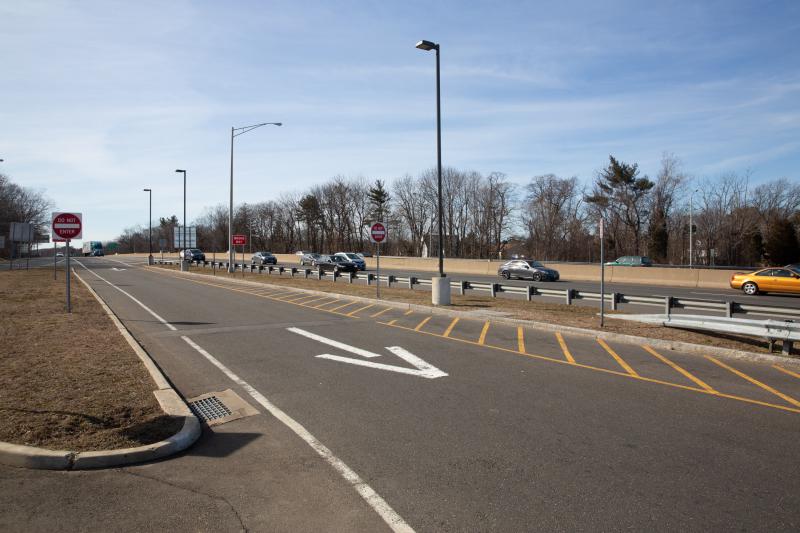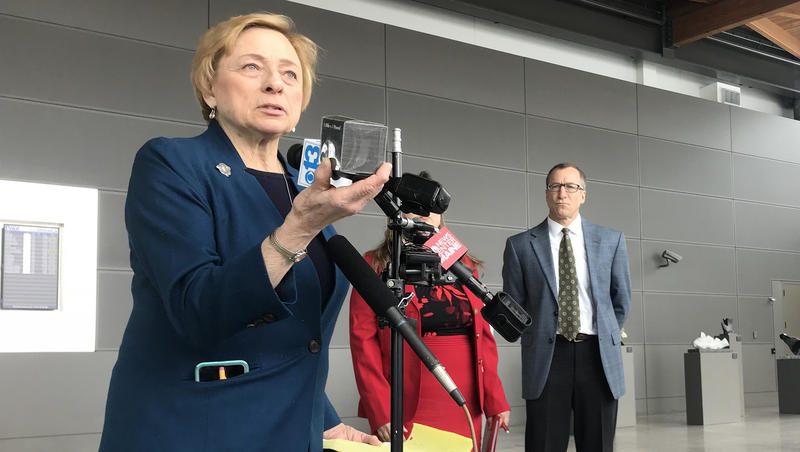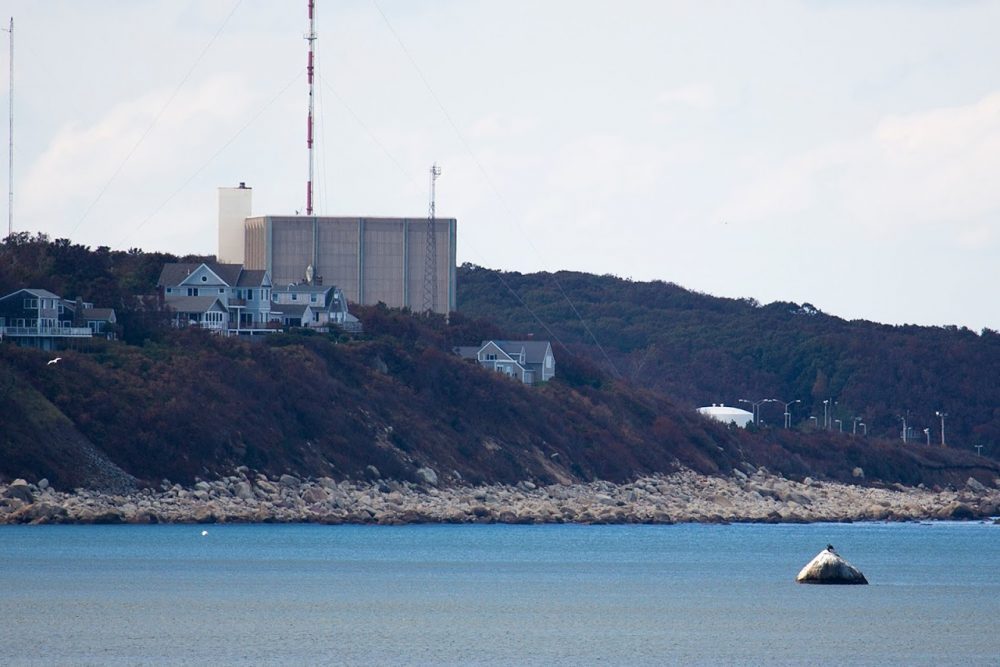Episode 135: Race And Policing On Martha’s Vineyard; The Present And Future Of Nuclear Power

This week on NEXT:
We’ll talk about how regional issues are playing out in state capitals, including discussions of tolls, clean-ups of the region’s waterways, and cross-state transmission lines.
Plus, we look at the future of nuclear energy around our region.
Finally, we’ll go to Maine and Martha’s Vineyard for a discussion of race.
It’s NEXT.
*Next week on NEXT: We’re discussing access to broadband around New England. Do you live in our region and have trouble accessing the internet? We want to hear from you! Send us an email at NEXT@ctpublic.org.
Photo above: Richard Shepard and Joyce Rickson lead the way during NAACP organized march. January 2015. Vineyard Haven, MA. Photo by Ivy Ashe.
Looking Back at Connecticut’s Long History with Tolls

Interstate 95 is one of several highways were lawmakers are considering putting tolls. Photo by Patrick Skahill for Connecticut Public Radio
We’re going to start this week’s show by taking you inside some of New England’s capitals, to see how governors and lawmakers are addressing issues with interstate impact.
Let’s start on our roads, where, at least in four New England states, you’re pretty familiar with paying tolls. In some states that still means old-fashioned toll booths where you stop and hand someone money. In others, like Massachusetts, new overhead gantries record when you go through with an E-ZPass, or they send you a ticket in the mail if you don’t have one. The problem is, a lot of people aren’t paying. Massachusetts reported that out-of-state drivers owe nearly $27 million in unpaid tolls to the Commonwealth. And the biggest scofflaw state is tiny Connecticut, directly to the south.
One reason why CT drivers might not already have an E-ZPass, or might just ignore a letter from the Mass DOT: there’s no agreement between Massachusetts and Connecticut that would hold drivers responsible if they don’t pay their tolls in neighboring states. The other big reason is that residents of Connecticut haven’t had to pay any tolls on their own state roads for more than three decades.
But that might be changing. New Connecticut Governor Ned Lamont re-introduced the idea of tolling in his budget address, saying toll money could be used to rebuild highways and bridges suffering from decades of neglect. And that could be a lot of toll money, as most traffic from the South that goes into New England goes straight through the Nutmeg state.
But as Connecticut Public Radio’s Patrick Skahill reports, tolls have a long history as a political third rail.
Vermont’s Governor Focuses on Clean Water Issues

The Scott administration’s proposal for clean water funding has received a tentative stamp of approval from the EPA, which oversees Vermont’s pollution-reduction efforts for Lake Champlain, pictured, and other waterways. Photo by Meg Malone for VPR
By the way, the other state in our region with no tolling: Vermont. But that’s really no surprise. They haven’t even had roadside billboards for about 50 years.
What Vermont lawmakers are grappling with this year is a different interstate issue, though: the health of large bodies of water. Vermont is bordered on one side by the long Connecticut River, and on the other by massive Lake Champlain. Both need attention to address pollution concerns. But where’s the money going to come from to clean them up?
Vermont Public Radio’s Capital Bureau Reporter Peter Hirschfeld joined us to discuss what’s going on in Vermont.
You can read Peter’s reporting on Vermont Governor Phil Scott’s budget address, and his reporting on the EPA’s reaction to Governor Scott’s clean water plans.
Governor Mills Expresses Support for CMP Transmission Line

Gov. Janet Mills holds up a pound of carbon at a press conference at the Portland Jetport on Thursday. Photo by Fred Bever for Maine Public
Our last legislative stop is in Augusta, Maine, where New Governor Janet Mills and two environmental groups are signing on to Central Maine Power’s bid to build a controversial new transmission line through western Maine’s forests. That transmission line is being built to get energy from Quebec’s rich hydropower system, down to the hungry consumers in Massachusetts.
But as Maine Public’s Fred Bever reports, the deal is drawing fire from other environmental groups, grassroots opponents, and some renewable energy developers in Maine.
Casks of Nuclear Waste Sit at Closed Nuclear Plants for Decades
A recent article from The Boston Globe caught our eye. In it, reporter Joshua Miller reports on the casks of nuclear waste that are sitting at nuclear power stations in our region, plants that were closed decades ago. Scientists, plant operators, and lawmakers insist they’re safe, but how much are taxpayers shelling out to keep this waste on-site?
Just this week, owners of the decommissioned plants in Connecticut, Massachusetts and Maine were awarded more than $103 million dollars by a federal judge to pay for the federal government’s failure to take this waste off their hands.
We called up The Boston Globe’s Joshua Miller to find out more.
Read Joshua Miller’s article, “These Dumpsters of Old Nuclear Waste Are Costing Taxpayers a Fortune”.
The Future of Nuclear Power in New England
As Vermont Yankee Nuclear Power Plant stopped production in Vernon, Vermont, and as Pilgrim Nuclear Power Station in Plymouth, Massachusetts moves to close later this year, what is the future of nuclear power in our region?
Soon New England will only have Seabrook Nuclear Power Plant operating in New Hampshire and Millstone Nuclear Power Plant operating in Connecticut, so what does this mean for our energy mix and for ratepayers in our region?
We invited Jacopo Buongiorno, a Professor and the Associate Department Head of MIT’s Nuclear Science and Engineering Department, in to discuss what’s next for our region.
For more on these issues, we recommend checking-out VPR’s Howard-Weiss Tisman’s reporting, “Vernon Gets Ready for Life Beyond Vermont Yankee,” and VPR’s John Dillon’s reporting, “Renew Nukes? Utilities Use Nuclear Energy to Help Meet Renewable Energy Goals.”
Why Is Maine So White?

Minter has created work that he says is about Malaga Island and the separation of interracial families at the hands of the state. This is a close up of the work. Courtesy of Daniel Minter
It’s a story we’ve been talking about for a while on NEXT. Almost 95 percent of people in Maine and Vermont identify as white according to the most recent census data. That number’s about 94 percent in New Hampshire.
The reasons why are complicated. So Maine Public Radio’s Willis Ryder Arnold went looking for an explanation.
Discussing Race, Racism and Policing on Martha’s Vineyard

Oak Bluffs Police Chief Erik Blake sits at his desk. November 2018. Oak Bluffs, MA. Photo by James Albert Sneed
Another place in our region that’s both a big tourist destination, and overwhelmingly white, is the Massachusetts island of Martha’s Vineyard. Fewer than 800 of the island’s 17,000 residents are African American.
But the island does have a local chapter of the NAACP, which calls itself “one of the most diverse racially and ethnically.”
Reporter James Sneed went there to talk to the chapter’s president.
This story was adapted from James’ piece for the Transom Story Workshop.
About NEXT
NEXT is produced at Connecticut Public Radio
Host: John Dankosky
Producer: Lily Tyson
Digital Producer: Carlos Mejia
Senior Director: Catie Talarski
Contributors to this episode: Patrick Skahill, Peter Hirschfeld, Fred Bever, Willis Ryder Arnold
Music: Todd Merrell, “New England” by Goodnight Blue Moon, “Ruin” by Cat Power, “Solar” by Viken Arman
—
New to NEXT? You can find every episode or one you missed within our archives.
We need your feedback! Send critiques, suggestions, questions, and ideas to next@ctpublic.org. Help us spread the word! If you like what you hear, rate and review us on iTunes.



